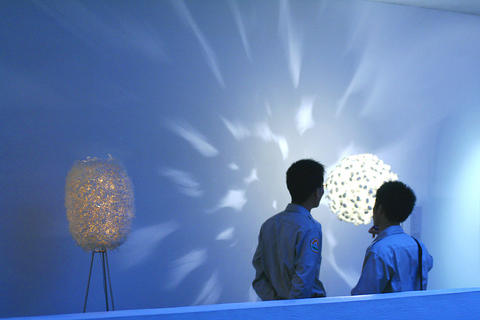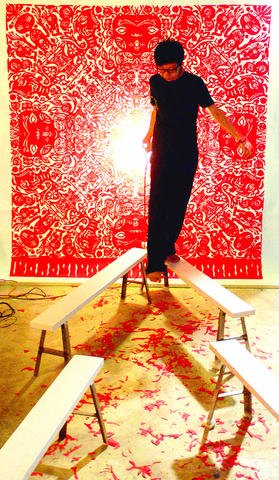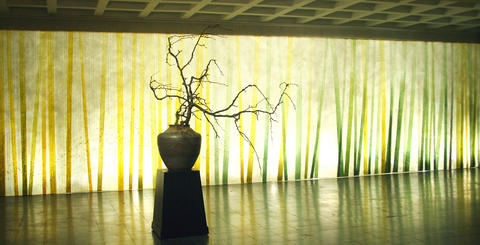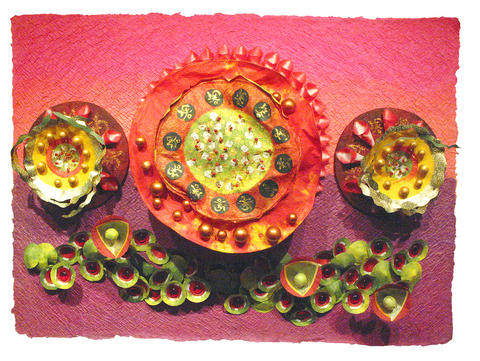Five decades after Chen Su-ho (陳樹火) founded one of the first factories specializing in handmade paper in Puli (埔里), Nantou County, his daughter has returned with an exhibition that gives the traditional craft a modern twist.
When Rita LiChen (陳瑞惠) was growing up, Puli was home to roughly 60 factories where paper was made by hand. Now only six remain. Watching the factories disappear - many moved to China - inspired her father to open a museum to preserve the memory of this chapter in Taiwan's cultural history.
LiChen's father died in a plane crash in 1990, but his dream lives on in the Suho Memorial Paper Museum (樹火紀念紙博物館) in Taipei. The museum is currently hosting its largest collaboration to date at the National Taiwan Craft Research Institute (國立台灣工藝研究所) in Nantou's Caotun Township (草屯). Zhi-Dao: Environment, Tranquility, Reverence (紙道:境,靜,敬) runs through April 27 and showcases the work of nine Taiwanese and international artists chosen by LiChen, who heads the Suho museum.

PHOTO: COURTESY OF TA YANG
"With this show, I wanted to destroy the entire concept of what 'paper' is," LiChen says. "Only by destroying this concept can artists find new ways to express themselves."
"Some people might think our work is too high-brow or think they can't understand it," she adds. "But I don't worry about that. If it's good, they'll naturally come to appreciate it."
Instead of selecting works by the best paper-makers and craftsmen in the field, Zhi-Dao presents a broad group of pieces ranging from paper-based lampshades and jewelry to contemporary art installations like Zeng Pei-ling's (曾沛玲) Tibetan Bhuddism-influenced wall hangings.

PHOTO: COURTESY OF TA YANG
Out of all the artists whose work is on display, Li Chao-cang (李朝倉) seems most set on pushing the boundaries of what "paper" is. Li has wrapped the entrance of the hall in a stretched white polyester tunnel that viewers have to duck through to access his main piece, a crude assemblage of reeds and other materials gathered from Nantou's flora and tied together to resemble the bamboo scaffolding commonly seen at construction sites.
Japanese artist Kobayashi Junko's Bamboo Forest, a giant 50m-by-3m sheet of paper that required the strength of 15 workers to lift and install, encircles the hall's second floor and dominates the exhibit. The paper's dyed vertical stripes gradually shift in hue as the viewer follows the piece around the room, suggesting the changing seasons. Delicate white paper slippers by Zhou Meng-ye (周孟曄) lie scattered in front of the piece. With a reflective score written for the show by Belgian composer Pierre Hujoel, the space exudes an air of serenity that makes viewers want to slip off their shoes and forget the winter cold and bustle of the holiday season.
A visit to the hall's fourth floor - not a part of the Zhi-Dao exhibit - gives visitors an idea of how irreverent LiChen's transformation of the conservative, craft-oriented institute was. Stone teapots carefully hewn to look like old wood, intricately carved bamboo frogs, wicker insects and lacquerware are displayed in glass cases, often with price tags next to them. Not quite the stuff of a modern art gallery.

PHOTO: COURTESY OF TA YANG
Plans for the exhibit met with opposition from staff at the cultural hall, though not from its director. Since the show runs through the Lunar New Year - a time to celebrate beginnings - some said Li's white tunnel wasn't appropriate because the color is traditionally associated with funerals and death. Three large white banners that were to be hung outside the hall advertising the show had to be redesigned, but Li's tunnel stayed.
LiChen has spent 13 years running the Suho Museum, which opened in 1995 after years of planning by her and her siblings. The museum is part of the Suho Memorial Paper Culture Foundation (樹火紀念紙文化基金會), founded after they lost both their parents in a plane crash. Eighteen years after the tragedy, Zhi-Dao is not only a remembrance of things past, but also a challenge to move forward.

PHOTO: BLAKE CARTER, TAIPEI TIMES

This month the government ordered a one-year block of Xiaohongshu (小紅書) or Rednote, a Chinese social media platform with more than 3 million users in Taiwan. The government pointed to widespread fraud activity on the platform, along with cybersecurity failures. Officials said that they had reached out to the company and asked it to change. However, they received no response. The pro-China parties, the Chinese Nationalist Party (KMT) and Taiwan People’s Party (TPP), immediately swung into action, denouncing the ban as an attack on free speech. This “free speech” claim was then echoed by the People’s Republic of China (PRC),

Exceptions to the rule are sometimes revealing. For a brief few years, there was an emerging ideological split between the Democratic Progressive Party (DPP) and Chinese Nationalist Party (KMT) that appeared to be pushing the DPP in a direction that would be considered more liberal, and the KMT more conservative. In the previous column, “The KMT-DPP’s bureaucrat-led developmental state” (Dec. 11, page 12), we examined how Taiwan’s democratic system developed, and how both the two main parties largely accepted a similar consensus on how Taiwan should be run domestically and did not split along the left-right lines more familiar in

Specialty sandwiches loaded with the contents of an entire charcuterie board, overflowing with sauces, creams and all manner of creative add-ons, is perhaps one of the biggest global food trends of this year. From London to New York, lines form down the block for mortadella, burrata, pistachio and more stuffed between slices of fresh sourdough, rye or focaccia. To try the trend in Taipei, Munchies Mafia is for sure the spot — could this be the best sandwich in town? Carlos from Spain and Sergio from Mexico opened this spot just seven months ago. The two met working in the

Many people in Taiwan first learned about universal basic income (UBI) — the idea that the government should provide regular, no-strings-attached payments to each citizen — in 2019. While seeking the Democratic nomination for the 2020 US presidential election, Andrew Yang, a politician of Taiwanese descent, said that, if elected, he’d institute a UBI of US$1,000 per month to “get the economic boot off of people’s throats, allowing them to lift their heads up, breathe, and get excited for the future.” His campaign petered out, but the concept of UBI hasn’t gone away. Throughout the industrialized world, there are fears that